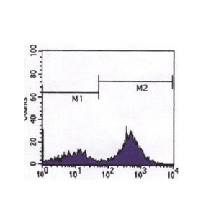Anti-CD3: Mouse Cluster of Differentiation 3 Antibody |
 |
BACKGROUND CD3 (CD stands for cluster of differentiation) is a protein complex composed of four distinct chains (CD3-gamma, CD3-delta and two times CD3-epsilon) in mammals, that associate with molecules known as the T cell receptor (TCR) and the zeta-chain to generate an activation signal in T lymphocytes.1 The TCR, zeta-chain and CD3 molecules together comprise the TCR complex. The CD3-gamma, CD3-delta and CD3-epsilon chains are highly related cell surface proteins of the immunoglobulin superfamily containing a single extracellular immunoglobulin domain. The transmembrane region of the CD3 chains is negatively charged, a characteristic that allows these chains to associate with the positively charged TCR chains (TCR-alpha and TCR-beta). The intracellular tails of the CD3 molecules contain a single conserved motif known as an immunoreceptor tyrosine-based activation motif or ITAM for short, which is essential for the signaling capacity of the TCR. Phosphorylation of the ITAM on CD3 renders the CD3 chain capable of binding an enzyme called ZAP70 (zeta associated protein), a kinase that is important in the signaling cascade of the T cell.2
REFERENCES
1. Salmeron, A. et al: J. Immunol. 147:3047-52, 1991
2. Portoles, P. et al: J. Immunol. 142:4169-75, 1989
2. Portoles, P. et al: J. Immunol. 142:4169-75, 1989
Products are for research use only. They are not intended for human, animal, or diagnostic applications.
Параметры
Cat.No.: | CP10034 |
Antigen: | Purified recombinant human CD3 epsilon-subunit expressed in E. coli. |
Isotype: | Mouse IgG2a |
Species & predicted species cross- reactivity ( ): | Human |
Applications & Suggested starting dilutions:* | WB n/d IP n/d IHC 1:200 - 1:1000 ICC n/d FACS 1:200 - 1:400 |
Predicted Molecular Weight of protein: | 12 kDa |
Specificity/Sensitivity: | Detects endogenous CD3 epsilon-subunit proteins in normal T cell lysates without cross-reactivity with other family members. |
Storage: | Store at -20°C, 4°C for frequent use. Avoid repeated freeze-thaw cycles. |
*Optimal working dilutions must be determined by end user.
Документы
Информация представлена исключительно в ознакомительных целях и ни при каких условиях не является публичной офертой








